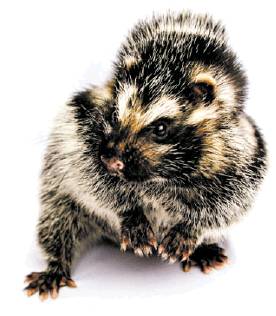This rat covers itself in poison |
The rats “very much have the personality of something that knows it’s poisonous,” said Sara Weinstein, a biologist at the University of Utah and the Smithsonian Conservation Biology Institute.
In sharp contrast to most of their skittish rodent kin, Lophiomys imhausi lumber about with the languidness of porcupines. When cornered, they fluff up the fur along their backs into a tip-frosted mohawk, revealing rows of black-and-white bands that run like racing stripes down their flanks — and, at their center, a thicket of specialized brown hairs with a honeycomb like texture.
Those spongy hairs contain a poison powerful enough to bring an elephant to its knees, and they are central to Weinstein’s recent research, which confirmed ideas about how this rat makes itself so deadly.
Give them a chance and African crested rats will take nibbles from the branch of a poison arrow tree. It’s not for nutrition. Instead, they will chew chunks of the plants and spit them back out into their fur, anointing themselves with a form of chemical armor that most likely protects them from predators such as hyenas and wild dogs. The ritual transforms the rats into the world’s only known toxic rodents, and ranks them among the few mammals that borrow poisons from plants.
Weinstein’s research, which was published last month in the Journal of Mammalogy, is not the first to document the crested rats’ bizarre behavior. But the new paper adds weight to an idea described nearly a decade ago, and it offers an early glimpse into the animals’ social lives.
People in East Africa have long known about the crested rat’s poisonous punch, which has felled many an over curious dog. (Those that survive their encounters tend to give the rats a wide berth.)
For their new paper, Weinstein and her team snared 25 rodents and filmed them in the lab. When offered cuttings of Acokanthera, some of the animals chomped on the bark then groomed it into their stripes.
Scientists still aren’t sure how often the rats anoint, or even how they tolerate the toxins themselves, especially if some of it ends up going down.



 RSS Feed
RSS Feed